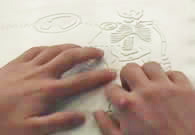INTRODUCTION TO TACTILE GRAPHICS
A Basic Overview
What Are Tactile Graphics?
Tactile graphics are images that are designed to be touched rather than looked at. When information in a print graphic is important to a tactual reader, a tactile graphic may be developed. The concept and content of the graphic are represented by a set of tactile symbols selected to be easily read and understood.
What Tactile Graphics are NOT
A tactile graphic is not a straight reproduction of the print graphic, or a tactile “photocopy” of the original. A tactile graphic does not include the symbols expected by visual readers, such as color, embellishment, and artistic additions.
Who Produces Tactile Graphics?
Braille transcribers produce textbooks that contain tactile graphics. Most often, the transcriber produces the graphic along with the braille text. Sometimes the transcriber works with another person who does the production of the graphic.
Teachers of students with visual impairment or blindness (TVIs) often produce tactile graphics to accompany classroom materials and activities, and for other instruction purposes such as orientation and mobility training.
Classroom teachers also produce tactile graphics for their students who read braille. With the support of a transcriber and/or a TVI, and with access to the appropriate materials and a little training, the classroom teacher can provide “on the spot” graphics as needed.
Students who are braille readers can also produce tactile graphics.
How are Tactile Graphics Made?
The following production methods are most commonly used in North America.
Collage
Collage is a method in which compatible textured materials are selected to represent the components of the print graphic (areas, lines and point symbols). The textures are adhered to a base surface which also contains labels, written in braille.
Textures that may be used for areas include textured craft papers, fabrics, handmade paper. Lines may be shown using heavy thread, cotton-coated small gauge wire, flat braids and trim. Point symbols can be shown using basic cardboard shapes, small metal rings or special tools that create designated symbols.
The collage method is often used to create a master tactile graphic which is then copied using a vacuum form process called Thermoform™. This production method is most often used for textbooks. In the school setting, the student often receives the original copy of tactile graphics produced using collage.
Tooling
This method produces a raised image on paper or aluminum diagramming foil. Using specially designed tools and working from the back side of the paper or foil, textures are embossed, creating the image on the front. Often these tools are also used in combination with other methods of production.
The product of tooling on paper may be Thermoformed for multiple copies or the original may be used by the reader. Tooling done on diagramming foil is most often Thermoformed. The teeth of the embossing tools may break through the surface of the foil slightly, making the master copy of the diagram uncomfortable and unsafe for the tactile reader.
Capsule paper and fuser
Also called swell graphics, puff pictures, and toaster graphics, this method is often used in schools because it offers quick production with minimal supplies. Simple diagrams can be prepared and immediately delivered to the student. Students can also create their own graphics.
A diagram image is transferred to capsule paper by photocopying, drawing by hand, or by printer. Capsule paper has been coated with millions of thermally foamed microcapsules that respond to irradiation (light energy) and cause the dark image on the paper to swell, creating the tactile graphic.

